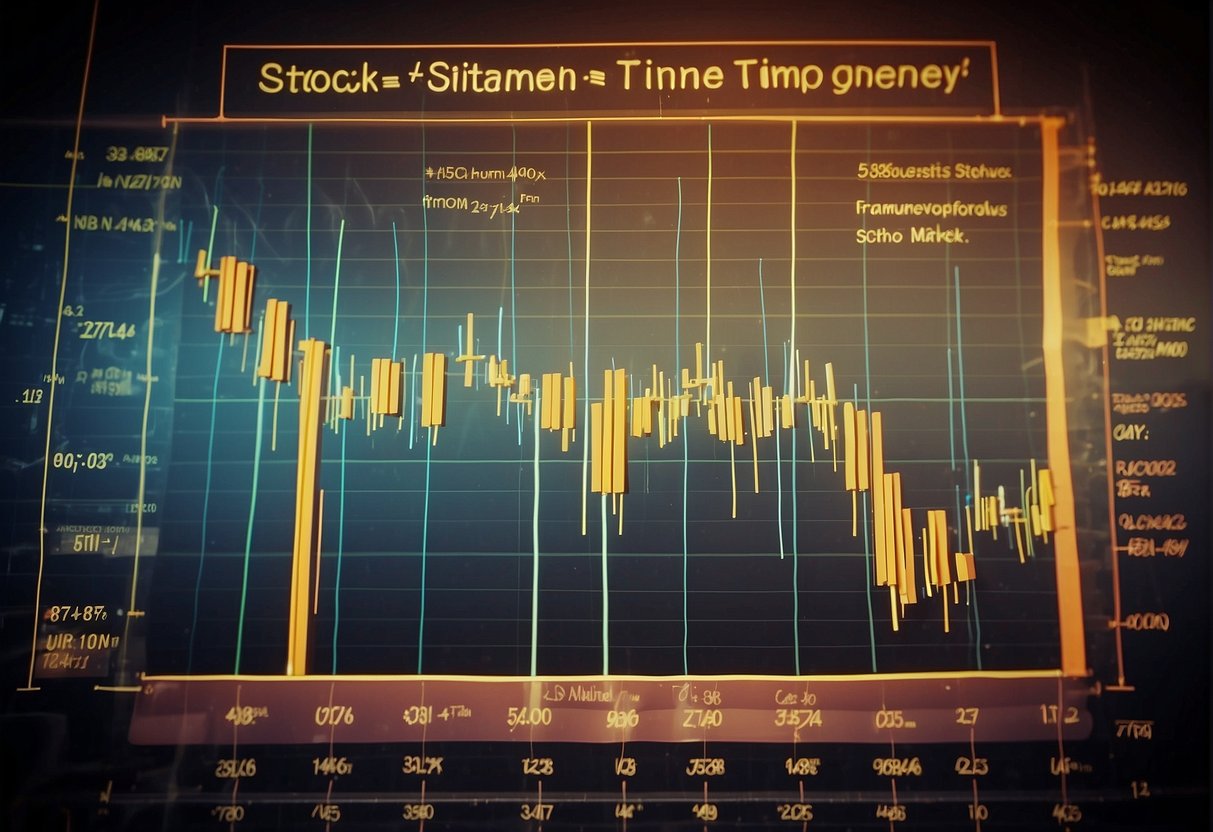Investors often employ market timing strategies to optimize their investment returns across various asset classes, such as stocks, bonds, and commodities. Market timing involves deciding to buy, sell, or switch between asset classes based on predictions of future price movements or using predictive methods such as technical indicators or economic data. While this approach may yield profitable outcomes in some cases, it remains a highly debated topic among investment professionals.

To use market timing effectively across different asset classes, investors must understand the unique characteristics of each asset and the factors influencing their price fluctuations. Economic indicators, market sentiment, and asset class performance must be considered to make well-informed decisions. However, engaging in market timing activities requires a certain level of risk tolerance and knowledge of the potential tax implications.
Key Takeaways
- Market timing can be employed across various asset classes, including stocks, bonds, and commodities, potentially optimizing investment returns.
- A deep understanding of each asset and the factors influencing price movements is crucial when using market timing strategies.
- When using market timing, investors must be prepared for risks and tax implications and possess a clear understanding of their own risk tolerance and time horizon.
Understanding Market Timing
Defining Market Timing
Market timing is the act of buying and selling assets, such as stocks, bonds, and commodities, to profit from their price fluctuations. The main goal of market timing is to capitalize on short-term price trends by predicting future movements of various asset classes. Typically, investors who practice market timing use various predictive methods such as technical indicators or economic data.
Example: An investor might buy stocks when they believe the market is at a low point and sell when they think it has reached its peak. This approach is based on the belief that they can predict these trends accurately enough to make a profit.
Theories Behind Market Timing
Several theories support the concept of market timing, each with its unique approach to identifying and capitalizing on market trends. Here are a few popular theories:
- Cyclical analysis: This theory is based on the belief that markets follow specific cycles and patterns. Investors analyze historical data to identify these patterns and anticipate what might happen. For example, they might study the business cycle to understand economic expansions and contractions.
- Technical analysis: Analysts use various tools and techniques to study past price movements and predict future trends. Some popular technical indicators include moving averages, trend lines, and support and resistance levels. By analyzing these metrics, investors hope to identify their trades’ perfect entry and exit points.
- Fundamental analysis: This approach involves studying the underlying factors that influence an asset’s value and performance. Fundamental analysts examine financial statements, industry trends, and economic data to determine an asset’s intrinsic value and compare it with its current price. If the price is lower than its intrinsic value, the asset is considered undervalued and could be a good buying opportunity.
When applied correctly, market timing strategies can help investors decide when to enter or exit different asset classes. However, it is essential to note that market timing is not without risks, as no method has proven consistently successful in predicting market movements. Therefore, investors should exercise caution and use a balanced approach when deploying market timing strategies.
Stocks and Market Timing
Timing Techniques in Equities
Market timing is buying and selling stocks to take advantage of price fluctuations. Investors using this strategy typically rely on predictive methods, such as technical indicators or economic data, to make trading decisions. Several techniques can be employed for timing equity investments:
- Fundamental Analysis: Evaluating companies’ financial statements to identify undervalued stocks.
- Technical Analysis: Analyzing price charts and patterns to identify trading opportunities.
- Economic Indicators: Monitoring macroeconomic data (e.g., GDP, inflation, and interest rates) to assess the overall health of the economy.
- Sentiment Analysis: Gauging market participants’ emotions and expectations to anticipate price movements.
Note: The effectiveness and success of these techniques may vary, and past performance is not necessarily indicative of future results.
Volatility and Stock Movements
Movement in stock prices can be attributed to volatility, which measures the degree to which a stock’s price fluctuates. High volatility often indicates uncertainty in the market, which can lead to more significant price swings. On the other hand, low volatility represents more stable conditions, with more minor fluctuations in stock prices.
Investors and traders can use various techniques to understand and potentially profit from volatility in the stock market:
- Historical Volatility: Examining past price changes to determine an asset’s typical price fluctuation over a specific period.
- Implied Volatility: Assessing the market’s expectations for future volatility by analyzing options prices.
- Volatility Indexes: Using instruments like the CBOE Volatility Index (VIX) to gauge the market’s expectations of future volatility.
Ultimately, timing the stock market can be a complex and challenging task due to the numerous factors affecting stock prices. Remember, market timing is just one of the many investment strategies, and it may not suit every investor’s objectives and risk tolerance. It is essential to consider your investment approach carefully and consult with a financial professional if needed.
Bond Market Dynamics
Interest Rate Predictions and Bond Pricing
Various factors, including interest rate predictions, influence bond market dynamics. Bond prices tend to fall when interest rates rise because newer bonds issued at higher rates are more attractive to investors, decreasing the demand for existing bonds with lower rates. On the other hand, when interest rates drop, bond prices typically rise, as existing bonds with higher rates become more attractive. These dynamics also affect different types of bonds, such as government bonds.
Investors looking for fixed-income opportunities can use interest rate predictions to gauge future market outcomes. However, this reliance on market timing can lead to inconsistencies and difficulties since interest rates can shift suddenly due to various economic factors and central bank policies.
Risk Management in Bonds
Understanding bond market dynamics helps investors manage risks across various asset classes, including stocks, bonds, and commodities. Managing risk in bonds often involves diversifying between short-term, intermediate-term, and long-term bonds and considering different sectors or industries.
When interest rates rise, short-term bonds tend to perform better, allowing investors to benefit from higher yields quickly. Conversely, long-term bonds generally perform better when interest rates fall due to their higher yields and longer duration. Intermediate-term bonds balance the potential returns of long-term bonds and the lower interest rate risk of short-term bonds.
In addition to diversifying across maturities, investors should consider investing in bonds from various sectors and industries. This approach helps mitigate the impact of industry-specific risks and market shocks while maintaining the desired income level from the bond portfolio.
In summary, bond market dynamics are affected by interest rate predictions and risk management strategies. By understanding these elements, investors can make informed decisions about allocating their bond holdings in various market conditions, though relying solely on market timing is not advisable.
Exploring Commodity Investments

Assessing Commodities Market
Commodities are essential investments to consider for diversification purposes. They are classified into four main types: precious metals (such as platinum, copper, silver, and gold), energy resources (including gasoline, crude oil, and heating gas), agricultural products (corn, soybeans, wheat, etc.), and livestock (cattle, hogs, and poultry). The prices of these commodities tend to fluctuate based on supply and demand, as well as numerous other factors, such as geopolitical events, economic indicators, and even weather patterns.
One of the popular ways to invest in commodities is through commodity ETFs, which often track an underlying index and provide exposure to a diverse range of investments within a specific commodity class.
Timing and Price Movements
Market timing is an investment strategy that involves moving in and out of various asset classes, including commodities, based on predictive methods like technical indicators or economic data. While attempting to capitalize on price movements in commodities through market timing could potentially yield profit, this approach carries significant risks, as accurately predicting the direction of prices can be complex and challenging.
In addition to their potential for high returns, commodities may serve as a hedge against inflation. For example, the S&P Goldman Sachs Commodity Index (GSCI) returned 37.1% in 2021, outperforming the S&P 500 and other equity indices due to increased inflationary pressures.
It’s important to note that commodity investments can be volatile, with prices experiencing significant movements both up and down. As such, considering the risks involved and understanding one’s investment objectives and risk tolerance is crucial before allocating a portion of a portfolio to commodities.
Footnotes
Analysing Asset Class Performance
Comparing Asset Classes by Returns
One useful metric is the average return over a certain period when considering the performance of different asset classes, such as stocks, bonds, and commodities. This can provide insights into each asset class’s potential for growth and risk. For example, stocks typically have higher returns and volatility than bonds and cash equivalents 1.
Here’s a brief comparison of historical returns for various asset classes:
- Stocks: Over long periods, stocks have displayed higher returns than other asset classes, making them popular among investors seeking capital appreciation.
- Bonds offer lower returns than stocks, but they are also less volatile and provide a steady stream of income.
- Commodities: The performance of commodities can be highly volatile and may depend on factors such as supply, demand, and global economic conditions.
Correlation and Diversification Benefits
In addition to analyzing individual asset class performance, it’s essential to understand the correlation among these asset classes. Correlation measures the degree to which two or more assets move in relation to each other 1. A well-diversified portfolio contains assets with low correlations, which can help reduce overall portfolio risk.
Here’s an overview of how different asset classes tend to correlate:
- Stocks and Bonds: Generally, stocks and bonds have a low or negative correlation, which can help offset each other’s fluctuations and reduce overall portfolio risk.
- Stocks and Commodities: The correlation between stocks and commodities may vary depending on factors such as the commodity being considered and global economic conditions. Sometimes, they can be positively correlated, while others may display negative or minimal correlation.
- Bonds and Commodities: Similar to stocks and commodities, the correlation between bonds and commodities may vary depending on the specific commodity and market conditions.
Understanding these correlations and incorporating low-correlations assets into a portfolio can provide significant diversification benefits. By spreading investments across multiple asset classes, investors can potentially reduce risk and achieve a more consistent portfolio return over time.
Investment Strategies and Timing
Strategic vs. Tactical Asset Allocation
Strategic asset allocation involves creating a long-term plan for an investment portfolio based on the investor’s goals, risk tolerance, and time horizon. This plan includes a target mix of asset classes such as stocks, bonds, and commodities. Investors following a strategic approach generally stick to their strategy over time, periodically rebalancing their portfolio to maintain their target allocation.
On the other hand, tactical asset allocation is a more active investment strategy in which the investor adjusts the portfolio’s asset allocation based on their short-term market views or changes in market conditions. This approach may involve timing the market or switching between asset classes to maximize potential opportunities or minimize risks.
Buy-and-Hold Versus Timing Approaches
The buy-and-hold approach is a long-term investing strategy where investors maintain a stable asset allocation, regardless of market conditions. Investors following this approach believe in the long-term growth potential of their investments and are willing to ride out short-term market fluctuations. Research suggests long-term investors often fare better by investing in stocks, even at the worst time each year, rather than trying to time the market.
In contrast, market timing strategies involve buying or selling decisions based on predictions of future price movements. Investopedia describes various methods, such as technical indicators or economic data, for this purpose. Timing approaches can be applied to asset classes, including stocks, bonds, and commodities. However, market timing is often criticized for its potential to backfire and lead to subpar returns.
Pros and Cons of the Buy-and-Hold and Timing Approaches:
| Approach | Pros | Cons |
|---|---|---|
| Buy-and-Hold | Simplicity, lower transaction costs, long-term growth potential | Exposure to short-term market fluctuations |
| Timing Approaches | Potential to capitalize on short-term market opportunities | Higher risk, increased transaction costs, potential for subpar returns |
Both strategic and tactical asset allocation strategies can incorporate elements of the buy-and-hold and timing approaches. When choosing an investing strategy, it’s essential to consider risk tolerance, investment goals, and available resources. Ultimately, an individual’s most influential investment strategy depends on their unique circumstances and preferences.
Portfolio Management Techniques

Rebalancing for Risk Control
Rebalancing is a crucial aspect of portfolio management that aims to maintain the desired level of risk in an investment portfolio. It involves periodically adjusting the asset allocation by purchasing or selling securities to sustain the initial target allocation for different asset classes such as stocks, bonds, and commodities. This ensures the portfolio remains well-diversified and aligned with the investor’s risk tolerance and long-term objectives.
There are different methods for rebalancing a portfolio, such as:
- Time-based rebalancing: This technique involves adjustments at predefined intervals, such as quarterly or annually. For example, an investor might review the portfolio’s performance every quarter and buy or sell the necessary securities to maintain the target allocation across asset classes.
- Threshold-based rebalancing: This method focuses on percentage deviations from the target allocation. Portfolio managers set acceptable tolerance ranges for each asset class, and when the allocation drifts beyond these thresholds, the manager takes action to rebalance accordingly.
Role of Portfolio Managers in Timing
Portfolio managers are critical in implementing market timing strategies for investors, mainly when dealing with various asset classes. They assess prevailing market conditions and economic indicators to determine the best time to invest in different assets or adjust the portfolio’s exposure to specific sectors or industries.
Some techniques employed by portfolio managers to capitalize on market timing opportunities include:
- Sector rotation: Portfolio managers might shift investment allocations between industries or sectors based on economic indicators or market trends. For example, during a recession, they may reduce exposure to cyclical industries and increase investments in defensive sectors.
- Tactical asset allocation: This strategy involves consistently adjusting the portfolio’s allocation across asset classes to exploit short-term market conditions or opportunities. This may include increasing stock exposure during a bull market or focusing heavily on bonds in a bear market.
In conclusion, effective portfolio management techniques, such as rebalancing and strategic market timing, can help enhance returns and manage risk across asset classes like stocks, bonds, and commodities. Portfolio managers are instrumental in employing these strategies and ensuring the investor’s objectives are consistently met.
The Impact of Economic Indicators

Market Predictions and Economic Data
Economic data plays a vital role in predicting market conditions. Investors and analysts examine various economic indicators to gain insights into the economy’s health and make informed decisions about different asset classes like stocks, bonds, and commodities. These critical indicators include GDP growth, inflation, unemployment, and interest rates.
When analyzing the release of new economic data, financial markets often experience immediate volatility. This is particularly true if the information is significantly different from market expectations. For instance, a sudden increase in unemployment rates might lead to negative investor sentiment and a drop in stock prices.
Using Forecasts to Time the Market
Timing the market involves strategically moving investment capital between asset classes based on predictions and economic indicators. The goal is to identify bullish or bearish market trends and adjust investment strategies accordingly. While this approach has its supporters, critics argue that consistently timing the market is challenging,
To use forecasts effectively, investors should consider a range of indicators and avoid relying solely on a single data point. By incorporating various economic indicators, they can develop a comprehensive view of market conditions and make better-informed predictions about different asset classes. However, it’s essential to be cautious when using economic forecasts, as unforeseen events or inaccurate data can cause significant shifts in market trends.
In conclusion, economic indicators can directly impact market predictions and influence investor decisions across different asset classes. By using a combination of economic data, investors can identify market trends and potentially time their investments to take advantage of these trends. However, it’s crucial to be cautious in relying solely on economic forecasts since market fluctuations can be unpredictable.
Footnotes
Trading Psychology and Market Sentiment

Emotion-Driven Decision Making
Emotion plays a significant role in traders’ choices when investing in different asset classes, such as stocks, bonds, and commodities. They may be influenced by fear of losing out, leading to impulsive decision-making like buying at high prices or selling at lows. On the other hand, they might feel overconfident, which can result in too much risk. Understanding emotions related to trading and investors’ behavior is essential because it can impact market performance and individual investments.
Various factors contribute to emotional decision-making, including:
- Market news: Breakthrough announcements, political updates, or economic data can result in rapid changes in attitudes and emotions amongst traders, leading to erratic decisions.
- Trends: If a share or commodity is on an upward trend, traders may feel the urge to join the bandwagon, regardless of whether the movement is based on logic.
- Social influences: Many investors feel pressured to keep up with their peers or public sentiment, which often sways them to make decisions based on the prevailing thoughts and feelings in the market.
Investor Sentiment and Market Trends
Investor sentiment is the collective attitude of participants in the financial markets and can drive market trends for assets such as stocks, bonds, and commodities. There is a strong connection between market sentiment and market movements. A bullish sentiment, characterized by optimism and confidence, can cause asset prices to increase, while a bearish sentiment, reflecting fear and uncertainty, can lead to a decrease in prices.
Several sentiment indicators can help assess the overall attitude of investors. A few commonly used indicators are:
- Fear and Greed Index: This reveals market sentiment from extreme fear to extreme greed and can help identify significant shifts in the market environment.
- Put/Call Ratio: The ratio of put options to call options measures overall investor sentiment, providing a general understanding of the market’s inclination towards bullish or bearish activity.
- Volatility Index (VIX): A measure of the implied volatility in options on the S&P 500 index, the VIX can indicate overall market sentiment and risk perception.
Utilizing sentiment indicators, understanding emotion-driven decision-making, and recognizing the psychological aspects of trading can help investors make more informed decisions about market timing across different asset classes. This is a critical component for traders to consider when analyzing market trends for stocks, bonds, and commodities.
Assessing Returns and Growth
Measuring Investment Returns
When assessing the performance of different asset classes like stocks, bonds, and commodities, one key factor to consider is investment returns. Returns can be measured in various ways, such as absolute, annualized, or risk-adjusted returns. For example, the performance of asset classes can be assessed by comparing their potential gains and losses.
The Compound Annual Growth Rate (CAGR) is a standard return evaluation metric. It is the average annual growth rate of an investment, which considers the effects of compounding. As it accounts for the reinvestment of returns, CAGR can provide a clearer understanding of an asset’s growth over time.
Growth Potential and Market Timing
Another essential aspect of investing in different asset classes is evaluating their growth potential. Growth potential refers to the possibility of an investment increasing in value over time. Investors often have to weigh the potential returns against the risks involved in investing in certain asset classes, such as dynamic asset allocation strategies.
Market timing is a strategy that some investors employ to capitalize on growth potential in various asset classes. This approach involves moving in and out of the market or switching between asset classes based on predictive methods such as technical indicators or economic data (Investopedia). However, market timing can be challenging to execute successfully, and if not done correctly, it may lead to lower returns or even losses.
When considering market timing across different asset classes, investors should be aware of each class’s unique characteristics and growth potential. For example, stocks generally offer higher growth potential but also come with higher risks, while bonds might provide more stable returns, albeit with lower growth potential. Commodities, like gold and oil, can be valuable as hedges against inflation and other market conditions but tend to be more volatile regarding growth.
In summary, measuring investment returns and assessing growth potential are crucial when evaluating different asset classes and incorporating market timing strategies. By understanding the risks and opportunities associated with each class, investors can make more informed decisions and work toward achieving their financial goals.
Analysis Methods: Technical Vs. Fundamental

Applying Technical Analysis
Technical analysis is a methodology applied to different asset classes, such as stocks, bonds, and commodities, to predict future prices. It focuses on statistical trends in the asset’s price, volume, and other market data over time. Standard tools used in technical analysis include:
- Charts: Various types of charts, such as line, bar, and candlestick charts, help visualize price movements and patterns.
- Indicators: Technical indicators such as moving averages, relative strength index (RSI), and Bollinger Bands help identify trends and potential entry/exit points.
- Candlestick Patterns: Specific patterns in candlestick charts indicate potential trend reversals or continuations.
Technical analysis can be applied to any tradable financial instrument and is widely used by short-term traders seeking to capitalize on price fluctuations.
Fundamental Analysis for Long-Term Investing
Fundamental analysis evaluates securities by attempting to measure their intrinsic value. It involves assessing various qualitative and quantitative factors related to the asset’s issuer. For stocks, fundamental analysis includes:
- Company’s financial statements: Profit margins, revenue growth, and return on equity are some of the key ratios analyzed to determine a company’s financial health.
- Industry and market analysis: Understanding the industry’s dynamics, competitors, and market share helps to determine the company’s growth prospects.
- Macroeconomic factors: Interest rates, inflation, and economic growth can influence the asset’s overall performance.
Similar principles apply to bonds and commodities, but the focus is on the issuer’s creditworthiness (in the case of bonds) or macroeconomic factors affecting supply and demand (in the case of commodities).
Long-term investors use fundamental analysis to identify undervalued assets and make investment decisions based on their intrinsic value relative to the current market price.
Understanding Risk Tolerance and Time Horizon

Personalizing Investment with Risk Tolerance
Risk tolerance is a crucial factor in personalizing investments. It refers to an investor’s willingness to accept fluctuations and potential losses in their portfolio’s value. Individuals have varying risk tolerance, which age, financial goals, and personal experiences can influence. Typically, younger investors with a longer time horizon are considered more risk-tolerant, making them more likely to invest in higher-risk assets like stocks.
On the other hand, older investors approaching retirement may have a lower risk tolerance and prefer more conservative investments such as bonds. Understanding your risk tolerance allows you to build a suitable portfolio with the right balance of asset classes, such as stocks, bonds, and commodities.
Time Horizon Considerations in Market Timing
The investment time horizon significantly determines your approach to market timing across different asset classes. The time horizon is the length of time an investor expects to hold a particular investment before liquidating it. This can range from a few days or weeks for short-term traders to several years or decades for long-term investors.
For investors with a longer time horizon, market timing in stocks might not be as critical, as they can afford to wait out short-term fluctuations in the market. However, time horizon considerations become more crucial when dealing with bonds and commodities. For example, an investor with a shorter time horizon may be more cautious about trading bonds, as fluctuations in interest rates could significantly impact the value of their investment. Similarly, commodities traders with short time horizons should be extra cautious of market volatility and potential price swings.
In conclusion, understanding and considering risk tolerance and time horizon is crucial in crafting an investment strategy that balances diverse asset classes, including stocks, bonds, and commodities. Always remember that investing is a highly personalized endeavor, and tailoring your approach based on these factors can significantly impact your success in the market.
Tax Implications of Market Timing

Calculating Tax Consequences on Trades
Market timing involves frequent trading of different asset classes, such as stocks, bonds, and commodities. Investors must be aware of the tax consequences and transaction costs associated with these trades. For each trade, investors need to calculate their capital gains or losses and report them on their tax returns.
The capital gain or loss on a trade is calculated by subtracting the cost basis (purchase price plus any fees) from the net proceeds (sale price minus any fees). Maintaining accurate records of your trades, including dates and amounts, is crucial to correctly calculate and report your capital gains or losses.
Short-Term vs. Long-Term Capital Gains
The duration for which an asset is held in an investor’s portfolio plays a significant role in determining the applicable tax rate. The tax rate depends on whether the capital gain is classified as short-term or long-term.
- Short-term capital gains are realized from assets held for one year or less and are taxed at an individual’s ordinary income tax rate. Depending on the investor’s income bracket, this rate can be considerably higher than the long-term capital gains rate.
- Long-term capital gains are realized from assets held for more than one year and are subject to more favorable tax rates. The long-term capital gains rate in the United States ranges from 0% to 20%, depending on the investor’s taxable income.
Given these differences in tax rates, market timing strategies can significantly impact an investor’s tax liability. Frequent trading typically results in a higher proportion of short-term capital gains, which are taxed at a higher rate than long-term capital gains. Therefore, it is essential for investors who employ market timing strategies to be mindful of the tax consequences of their investment approach.
In conclusion, market timing can be applied to various asset classes, but investors must know the tax implications and transaction costs associated with frequent trading. By understanding the difference between short-term and long-term capital gains and adequately calculating the tax consequences of trades, investors can make more informed decisions and optimize their investment strategies.
Advising on Financial Planning and Investment
The Role of a Financial Advisor
A financial advisor plays a crucial role in guiding investors through the complex financial planning and investment world. Their primary responsibility is to offer clients tailored advice on various asset classes, such as stocks, bonds, and commodities, to maximize returns while managing risks. They use market timing strategies to enhance the performance of their clients’ portfolios. Financial advisors are deeply knowledgeable about market timing and understand how economic indicators, market trends, and technical analysis can be leveraged for investment decisions.
Financial advisors work closely with clients to assess their financial needs, evaluate risk tolerance and investment objectives, and design a comprehensive, personalized investment plan. This process is iterative and evolves as clients’ priorities and goals change over time.
Setting and Achieving Financial Goals
One of a financial advisor’s primary tasks is helping clients set and achieve their financial goals. This involves creating a roadmap for short-term, medium-term, and long-term goals, such as buying a house, saving for children’s education, and retirement planning.
A crucial aspect of achieving financial goals is having a diversified investment portfolio managed by a professional portfolio manager. By spreading investments across various asset classes like stocks, bonds, and commodities, a portfolio manager strengthens the investment strategy to meet market fluctuations. This also allows them to optimize returns while minimizing risks. Here are some strategies that financial advisors use to help clients achieve their financial goals:
- Asset Allocation involves dividing investments among different asset classes based on the client’s risk tolerance and investment objectives.
- Risk Management: Identifying the level of risk associated with each investment and implementing strategies to minimize potential losses.
- Diversification: Reducing a portfolio’s overall risk by investing in a wide range of assets.
- Market Timing: Capitalizing on short-term price fluctuations in various assets to optimize returns.
- Rebalancing: Periodically reviewing the portfolio and adjusting to maintain the desired asset allocation and risk profile.
Financial advisors play a critical role in designing and executing personalized investment plans to achieve clients’ financial goals. By leveraging their expertise in market timing and other investment strategies, they can help clients navigate the ever-changing economic landscape and make sound investment decisions for asset classes like stocks, bonds, and commodities.
Frequently Asked Questions
What strategies have proven to be effective in market timing for mutual funds?
Several strategies have been utilized for market timing in mutual funds, including technical analysis, moving averages, and relative strength index (RSI). While they can provide some insight, it is essential to note that no strategy guarantees success. Market timing is unpredictable, and even experienced professionals may struggle with consistent accuracy.
How does market timing differ for stocks versus commodities?
Market timing for stocks typically focuses on analyzing company-specific information, such as earnings reports, financial statements, and broader economic data. In contrast, market timing for commodities relies more on global supply and demand factors, weather conditions, and geopolitical events. Additionally, commodities trading often involves using futures contracts, which can complicate market timing decisions.
Are there observable patterns in market timing success across various asset classes?
Some patterns have been observed in market timing across asset classes, but regularly predicting these patterns is difficult. Success in market timing often comes down to an investor’s ability to interpret the complex interactions of various market factors, including economic data, sentiments, and technical analysis. However, it is essential to recognize that past performance does not guarantee future success, and market timing should not be the sole basis of an investment strategy.
How do market timing restrictions impact investments in retirement accounts like 401k?
Market timing restrictions are designed to limit excessive trading in mutual funds held within retirement accounts such as 401ks. These restrictions can include rules like redemption fees or short-term trading limits. The goal is to deter speculative trading and encourage long-term investing, as frequent trading can negatively impact mutual fund performance and increase costs for all investors within the fund.
In what ways does market timing influence long-term investment outcomes?
Market timing can significantly impact long-term investment outcomes, both positively and negatively. Successful market timing can lead to higher returns by capitalizing on market fluctuations. However, if market timing decisions are incorrect or poorly executed, they can lead to missed opportunities for growth or even losses. In the long run, a well-diversified investment portfolio focused on long-term goals is considered less risky and more likely to produce consistent returns.
What lessons can be learned from historical market timing scandals and their effects on investment strategies?
Historical market timing scandals can remind us of the potential risks and consequences of speculative trading behaviors. They highlight the importance of investment strategies prioritizing diversification, long-term planning, and risk management rather than attempting to capitalize on short-term market movements. Additionally, these scandals underscore the need for effective regulation and oversight of the financial markets to ensure a fair and transparent environment for all investors.
Conclusion
In investing, market timing can be applied to various asset classes, such as stocks, bonds, and commodities. Each of these asset classes has unique characteristics and market dynamics, making implementing market timing strategies across them challenging but intriguing.
For stocks, market timing involves predicting the future performance of individual companies or overall market indices based on economic data, technical indicators, or other factors. This approach aims to capitalize on fluctuations in the stock market to maximize profits and minimize losses. While several investors have succeeded with such strategies, it is essential to note that accurately timing the stock market is notoriously difficult and often unpredictable.
Bonds can also be subject to market timing strategies. Investors may attempt to time interest rate changes, which influence bond prices, by monitoring macroeconomic factors such as inflation, central bank policies, and global events. Nevertheless, these factors are often uncertain, and the bond market’s reaction may not always align with investor expectations. Additionally, Investopedia highlights that market timing can backfire, leading to missed opportunities and increased transaction costs for investors.
Lastly, commodities represent a unique challenge for market timing due to their diverse nature and dependence on supply and demand dynamics. Jittery mentions that geopolitical tensions, weather conditions, global economic growth, and government policies influence commodities such as oil, gold, natural gas, and agricultural products. These factors can make predicting commodity price trends a highly complex process.
- Stocks: Economic data, technical indicators
- Bonds: Interest rate changes, macroeconomic factors
- Commodities: Supply and demand dynamics, external factors
In conclusion, market timing can be applied to different asset classes, including stocks, bonds, and commodities. However, the degree of success in market timing across these asset classes often depends on the investor’s skills and the complex nature of the influencing factors. While it is an exciting strategy, investors should be cautious of the risks and challenges associated with market timing.




